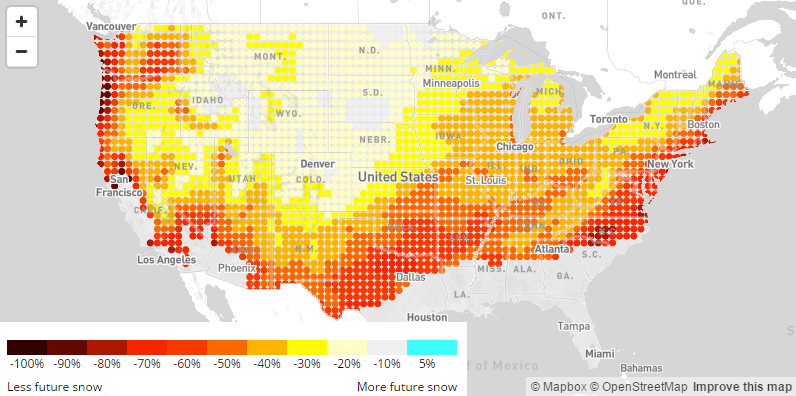Wait… high-performance buildings, snow and the desert… there’s a link?
-Written by John Cribbs
An interesting article was released one week ago today in The Desert Sun that got me thinking… How often do we hear or read about water? Not as often as we should. Why doesn’t it seem like anyone is as worried about the looming water crisis as I am? This is the topic of exploration in the following prose:
California is in the midst of its driest four-year period in nearly 1,000 years. Snow pack is receding higher into mountain ranges and the resultant snow melt is happening earlier in the year and more often throughout the winter. The following image depicts the future cast for this very statement.
What does this really mean?
Ultimately this results in less water volume (if any) downstream.
“It’s pretty dire. I think we need to start moving pretty quickly, whether that’s water conservation or even just more conversations about it. We’re going to have to figure out how to deal with water downstream differently” (Erin Stacy – Sierra Nevada Research Institute at UC Merced).
Does this have your attention yet?
It seems that many people dismiss this as myth or “a problem for tomorrow” but the reality is real. With this comes a deluge of water-use reduction and conservation mandates from local government agencies.
What can we do now?
The answer can be simple if we work together and reframe the problem. Instead of running from the issue and chalking it up as political pickle, we could, as a professional design community, utilize the constraint as an opportunity to embrace resilient water systems and drive innovation, behavior change and induce grass-roots policy influence and transformation. That’s essentially what the energy crisis has done for renewable energy sectors such as solar and wind systems. Why can’t we see the same successes within the world of water? Tiered pricing structure mimicking energy ratcheting, investment in water reuse and recycling infrastructure at both the building project scale and municipal scale, incentivized water-use reduction strategies for existing buildings and renovations, more integrated stormwater capture in new construction projects and developments… the list goes on. This can all be achieved through intelligent planning and design, but it won’t happen without you. A total metamorphosis in social behavior and design thinking is ultimately needed. Building science is upon us.
Are you ready for the next wave of design?
Take a look at the following map. In regions that pop up as red across the western U.S., “the climate of tomorrow will not be in a position to supply the water demands of today” (Justin Mankin – Columbia University). Is this alarming to anyone else?

SOURCE: Justin S. Mankin, et al., Environmental Research Letters
MAP: Robert Hopwood, The Desert Sun
What does this mean for buildings?
“There’s going to have to be more conservation. There’s going to have to be more water transferred from farms to cities. And it is increasingly unlikely that there’s going to be enough water, so something has to change.” – Gary Wockner (Save the Colorado).
Ultimately the city of tomorrow can’t mimic the city of today. High-performance buildings as test beds for new technology must become the new norm in order to effectively and intelligently plan for the integrated water infrastructures needed to support the city of tomorrow. Foster + Partners has teamed up with Nissan to future cast and plan the integrated city, fuel station of tomorrow. Who’s up for the challenge with water?



